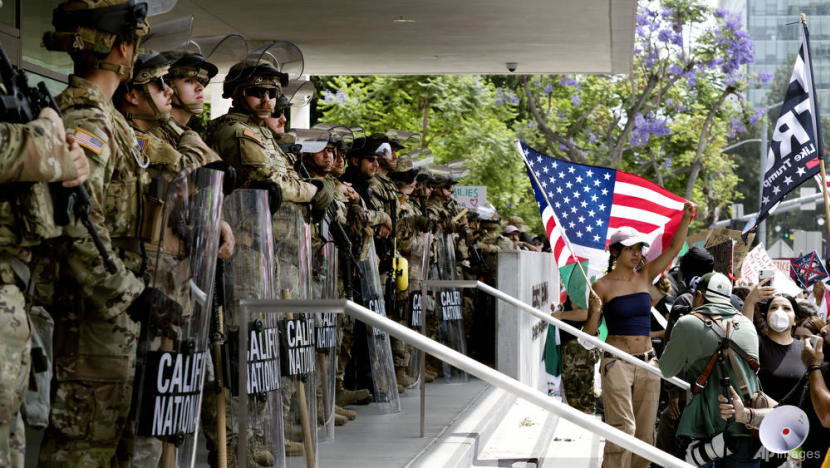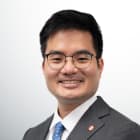Commentary: From Trump’s parade to ‘No Kings’ protests, the clash over what makes America great has only just begun
As President Donald Trump watched a display of American military might in Washington DC, protesters across the US presented a different version of patriotism, says Kevin Chen of the S Rajaratnam School of International Studies.
.jpg?itok=illBVGuY)
Composite photo: Demonstrators take part in the "No Kings Day" protest in Chicago (right); US President Donald Trump at a military parade in Washington commemorating the Army's 250th anniversary, coinciding with his 79th birthday, Sat June 14, 2025. (AP Photo/Nam Y Huh, AP Photo/Julia Demaree Nikhinson)

This audio is generated by an AI tool.
SINGAPORE: Two versions of American patriotism were on full display this weekend: a military-based message of might, and a grassroots-based outpouring of will. But the jury is still out over which version will triumph as the people and the Trump administration seek to define what makes America great.
On Saturday (Jun 14), more than 6,600 soldiers, 150 military vehicles and 50 aircraft paraded down Constitution Avenue in the heart of the American capital to commemorate the 250th anniversary of the United States Army. It was also President Donald Trump’s 79th birthday.
Across the rest of the country, millions of “No Kings” protesters demonstrated against the Trump administration’s policies and alleged abuses of power.
While the parade and protests did not physically meet, they are part of a larger struggle to define American patriotism.
DONALD TRUMP FINALLY GOT HIS BIG PARADE
Since the end of World War II, military parades have been rare, but not unheard of in American history. The US did not hold national or major city parades after the Korean and Vietnam wars, though an 8,000-troop-strong victory parade rolled down Constitution Avenue after the Gulf War of 1991.
One would have to go back even further to the 1950s and 1960s to find a military parade for a US president. Dwight Eisenhower and John F Kennedy featured military segments in their inauguration parades, but no modern president has repeated this display.
Many observers borrow Mr Eisenhower’s thoughts to explain this: Having the US military imitate Soviet parades makes it look weak. Mr Trump, however, would beg to differ.
His desire for a military parade began during his first administration, especially after he witnessed the Bastille Day parade in July 2017, calling it a “tremendous thing for France and for the spirit of France” and suggested that he would “try and top it”. In May, he expressed irritation that France and Russia were commemorating the end of World War II with elaborate celebrations while America was not.
As he told the crowd after the parade in Washington DC: “Every other country celebrates their victories. It’s about time that America did, too.”
A DIFFERENT VERSION OF AMERICAN PATRIOTISM
Meanwhile, the “No Kings” protests presented a different version of American patriotism – not about the conflicts its military has won but the systems and way of life it has protected, not about enforcing the law at all costs but upholding America’s system of checks and balances.
Hence, the name “No Kings”: Protesters criticise Mr Trump’s actions as overstepping the limits of a democratically elected president and more akin to a king.
It is difficult to ignore that the parade coincided with Mr Trump’s birthday, conflating his leadership with military strength. At least one veterans group turned down invitation to the official reviewing stand because they were uncomfortable with the political implications of the parade.
There is also a question of cost at a time of US government-funded programmes and federal jobs cuts. According to an AP-NORC poll, 60 per cent of Americans believed the parade was not a good use of government funds.
Mr Trump’s initial plans for a military parade in 2018 were frustrated by hesitant aides and a massive US$92 million price tag. This year, it was estimated to cost up to US$45 million.

More broadly, the parade took place amid growing protests against immigration crackdowns in Democrat-run cities.
Mr Trump ostensibly wanted to pit an image of power, order and stability against “lawless riots”. This is especially since the epicentre of recent protests is California, whose governor Gavin Newsom, has locked horns with Mr Trump and is reportedly positioning himself for a 2028 presidential run.
BUILDING UP TO A BIGGER POLITICAL CLASH
If Mr Trump wanted a spectacle, he certainly received one. In Washington, the parade rolled out despite threatening weather conditions, with generations of American military hardware from P-51 Mustangs to Abrams tanks proudly featured.
Yet, attendance for the parade appeared to be far below the 200,000 expected guests. Recordings that emerged from the parade were also less-than-flattering, from the squeak of threads from old Sherman tanks to soldiers awkwardly holding up drones as they marched.
In comparison, millions of protesters were estimated to have attended No Kings protests in all 50 states. If true, that would make it the largest single-day protest in American history, far bigger than the 2020 Black Lives Matter protests which peaked at 500,000 people.
Granted, attendance at political events does not equate to electoral support. Mr Trump won the popular vote just eight months ago, after all, despite months of sold-out rallies for then-Vice President Kamala Harris. Outrage over the immigration crackdown and other measures might fade by the midterm elections in 2026, let alone 2028.
However, it is clear that popular resistance to Mr Trump has returned at an unprecedented scale and level of coordination. It is likely that the political clash between the protesters and the administration has only just begun.
Kevin Chen is an Associate Research Fellow with the US Programme at the S Rajaratnam School of International Studies (RSIS), Nanyang Technological University (NTU), Singapore.


















